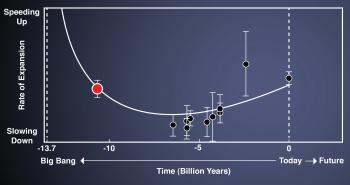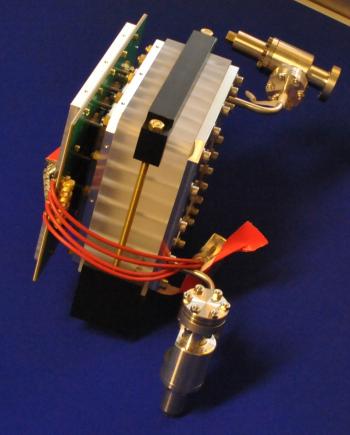
A neutrino interaction in the near detector ND280 of the T2K experiment in Japan. The green tracks represent the charged particles produced at the interaction point, which are reconstructed thanks to the TPC detectors, which were conceived by Saclay teams.
DPhP physicists are experimentalists. While designing experiments, they evaluate theoretical ideas, sometimes contribute directly to them, and confront them to the technical possibilities for testing. Then they participate to the detailed design of the detectors, their construction, and operation. Finally, they analyze the experimental data and compare it to the theoretical models considered. The strong link between physicists and technical support in the Institute is an essential asset. In most cases, the experiments are performed by international collaborations, each with several tens of participating teams. However, the impact of SPP physicists is often clearly apparent in the global design of an experiment, its mode of operation, or the results of its analysis.
The Physics of the Two Infinites
The scientific legacy of the twentieth century is outstanding, be it on the theoretical or the experimental ground. Special relativity and quantum mechanics, developed in the first decades, are combined in the thirties into quantum field theories, where each particle is the material instance of a field that fills up space and time, and where fundamental interactions emerge from symmetry principles. The Standard Model of Particle Physics gathers two of these theories. The first one, quantum chromodynamics (QCD), is conceptually particularly elegant, but also particularly complex when it comes to perform predictive calculations. The second one is the electroweak theory, which unifies electromagnetic and weak nuclear forces under a global symmetry. A principle of symmetry that is not obeyed by the fundamental state of the theory, which is know as quantum vacuum because it is void of actual particles. This phenomenon of symmetry breaking by the vacuum state, known as the Higgs mechanism, accounts for the very small range of the weak nuclear interaction on the one hand, and for the mass of the quarks, the charged leptons (electron, muon and tau lepton), and their antiparticles, on the other hand.
Modern cosmology builds on another monument of the physics of the twentieth century, Einstein's theory of general relativity. The Lambda-CDM model, promoted in the nineties as the Standard Model of cosmology, describes the expansion of the Universe and the formation of structures, and accounts for all cosmological observations. At large scales, the Universe is uniform, isotrope, and spatially flat, and its expansion proceeds through the influence of four components: ordinary matter, which represents 5% of the total ; dark matter, composed of hypothetical massive particles (25%) ; and a new form of energy, dark energy, which exerts a negative gravitational pressure responsible for the recently accelerated cosmic expansion (70%).

The study of the Lyman-alpha of a large number of distant quasars probes the large structure formation in the early universe, 10 billion years ago, at a time when the universe's expansion was decelerating under the gravitational influence of matter (red point, on the left) before the transition to an accelerated expansion caused by dark energy.
What an Exciting Period!
The twenty-first century has already offered outstanding experimental discoveries in particle physics and cosmology, to which SPP physicists have contributed : the discovery of the violation of the CP symmetry between matter and antimatter in the system of B mesons with the BABAR experiment (Nobel Prize in physics awarded to Japanese theorists M. Kobayashi et T. Maskawa in 2008); the discovery of the acceleration of the Universe expansion, which has led to the notion of dark energy (Nobel Prize in physics awarded to S. Perlmutter, B. Schmidt, and A. Riess in 2011); the progress in the understanding of neutrino flavour oscillations, which demonstrate that neutrinos have mass (Nobel Prize in physics awarded to T. Kajita and A. McDonald in 2015); and the discovery of the Higgs bosons in 2012 by the ATLAS and CMS experiments at the CERN LHC (Nobel Prize in physics awarded to theorists P. Higgs and F. Englert in 2013).
A Great Tradition of Physics at Saclay
For decades Saclay physicists have been among the key players in the experimental tests of the Standard Model of particle physics. Among the great particle physics experiments to which the SPP has participated in the past, let us mention: UA1 and U2 at the CERN SppS collider, where the vector bosons of electroweak interactions, the W and Z bosons, were discovered in the 80s; ALEPH and DELPHI (and also OPAL) at the CERN LEP electron-positron collider, where the Z boson has been studied and supersymmetry has been searched for; the D0 experiment, at the Fermilab (USA) Tevatron proton-antiproton collider, where the top quark was discovered in the 90s, and which produced high quality results along the 2000s; NA48 at CERN and BABAR at SLAC (USA), where the matter-antimatter asymmetry and the physics of heavy flavours of quarks with kaons and B mesons were studied; and H1 at the DESY (Germany) HERA electron-proton collider, where the quark and gluon content of the proton was measured.
The SPP has played to central role in the physics of neutrinos, at power reactors such as Bugey or research reactors such as Osiris (Saclay), with the detection of solar neutrinos with the Gallex experiment, and of course, with a series of CERN neutrinos experiments, including the NOMAD experiment in the 90s.
The quest for dark matter is also a long tradition at Saclay, in particular with very low background experiments exploiting scintillating crystal and bolometric detectors, such as the Edelweiss experiment at the Modane Underground Laboratory. The indirect search for dark matter started in the 90s with the EROS experiment for the detection of brown dwarfs by gravitational lensing in the direction of the Magellan Clouds, then with the under-sea neutrino detector ANTARES, in the Mediterranean, and the network of Cherenkov telescopes for the detection of very high energy gamma rays in the Namibian desert.
Cosmology is a more recent scientific activity at Saclay, which started in the 2000s with the exploitation of supernovae SN1A as standard candles for measuring the acceleration of the cosmic expansion, with the SNLS experiment, and with the participation to the Planck satellite, whose observation of the cosmic microwave background have led to precise measurements of the cosmological parameters and the study of galaxy super clusters. SPP cosmologists have developed an expertise in the exploitation of the baryon acoustic oscillations (BAO) and the analysis of the Lyman-alpha forests in the spectra of distant quasars, as well as in hydrodynamical simulations out of which limits of the sum of the neutrino masses can be placed.

The aim of the CaLIPSO project of a fast and efficient 511 keV-gamma ray detector with excellent spacial resolution, is to provide a key technology for the next generation of PET (Positron Emission Tomography) imaging.
Scientific Life at the DPhP
As of Spring 2016, the SPP hosts 73 staff physicists, 68 of which are CEA employees, 6 post-doctoral researchers, 33 PhD students, and two administrative assistants. The physicists are organised in about 15 teams of 3 to 18 physicists. Many SPP physicists are also teaching at various academic levels.
The SPP secretariat takes care of all administrative issues. The well-being of PhD students is a priority at SPP. Each students has a tutor (a "god father") of his/her choice to assist him/her during the course of the thesis.
The scientific council of the SPP (CSTS) meets about two times a year to review the progress of ongoing experiments, examine new projects of experiments, and determine the medium- and long-term scientific objectives of the SPP.
Seminars are organised every Monday, an informal gathering every Friday ("apéro"), as well as thematic meetings to discuss the latest publications in a given field (neutrinos, cosmology).
